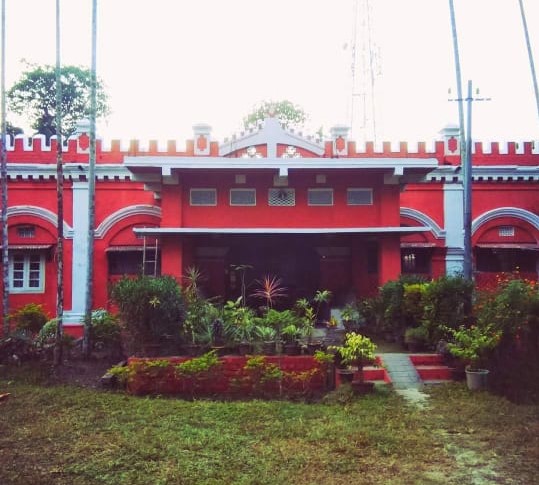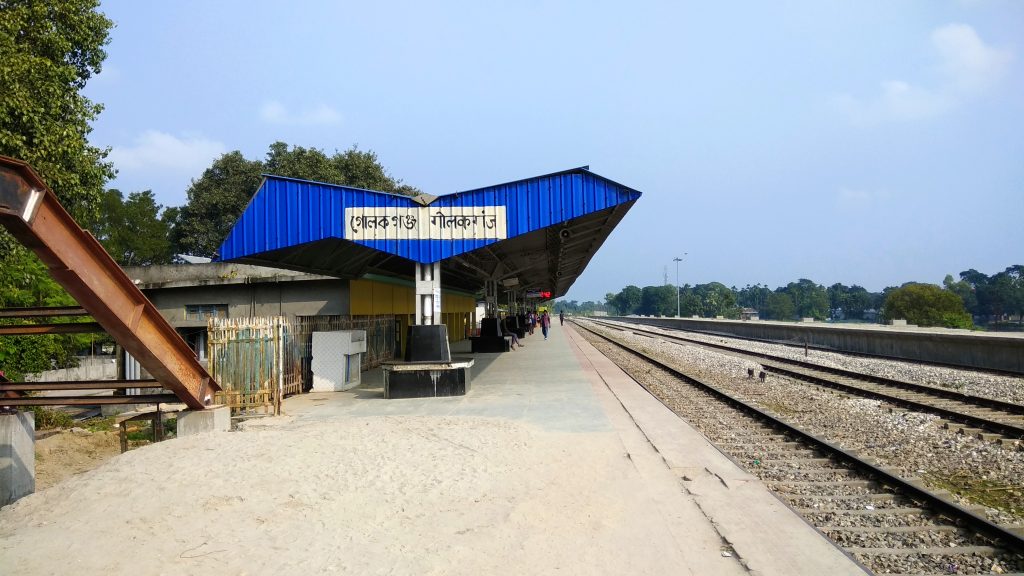

Before 1901 there was no place called Golakganj. The place was known as Tokrerchara and was in fact pretty insignificant. It was not even a proper market but largely for the chhara or the water body. Other than paddy, the place also used to produce jute and that was one of the major attractions of the small-time merchants to sail upward in their boats from the downstream of the river Gangadhar and buy jute from the farmers. Till the late nineteenth century many sailors used to come to this place to do their trade in the nearby haats of Materjhar and Pratapganj which were the major markets in the western part of the zamindar of Gauripur, who used to be called by the laity as the Raja Bahadur. As typical of the markets, Pratapganj and Materjhar attracted many merchants including the Marwaris. The Marwaris used to come to the district of Goalpara since the mid-18th century. Among the early Marwaris to Pratapganj were the Kanhailals of Pratapganj. Kanhailal had first arrived at the Dhubri port which was the district headquarters of Goalpara, but the main place was Gauripur which was the capital of the Raja Bahadur of Gauripur. In fact, it was Raja Pratap Chandra Barua who had donated the land to the British to set up their district headquarters at Dhubri. Raja Pratap Chandra Barua shifted their capital from Rangamati to Gauripur in 1850. Pratap Chandra was the descendent of Kabindra Patra who was the first zamindar of Gauripur and was one of the trusted generals of Chilarai, the legendary Koch warrior. His son Raja Prabhat Chandra Barua was an illustrious ruler. Golok Barua was one of the sons-in-law of the Gauripur Rajbari who was given the western part of the estate to look after which which comprised some of the major haats like Materjhar, Pratapganj, Tamarhat, Harirhat, Paglahat, Agomani and others.
Assam Railway and Trading Company under the British had introduced the railways in Assam in 1881 in upper Assam between Dibrugarh and Margherita. The purpose of the track was primarily to ferry timber and other forest resources and coal. Assam was not yet connected to the rest of country by railways. It happened in 1901 when they had opened a line to Assam through Golakganj. As per the railway plan to take the line from Lalmonirhat, Gitaldaha, Bhurungamari in Rangpur subdivision (now in Bangladesh) to Assam they had chosen the small village Torerchara as the Gateway to Assam. But then to lay the line they needed a considerable amount of land. At that it was Golok Barua who had agreed to offer land with the conditions that the railway track would be laid on the land he would provide and the railway station at the Tokrerchara village must be named after him. The British Railway company had agreed and named the station as Golokganj junction as it became the point for the track to divert to Dhubri and towards Fakiragram. In 1901, with the coming up of the station, the place came to be known as Golokganj and the otherwise insignificant village began to grow as an important place. That was the time when many Marwaris too began to come to Golakganj as it grew as a major trading centre as communication became easy to reach markets at Bhurungamari Lalmonir Hat and other places in Rangpur district, and more importantly Calcutta came closer to Golakganj. Under the Gauripur estate, the Golokganj became an important part of which Jogomohan Prodhani was the jotedar who was locally called the zamindar.
There were many stories about Golokganj railway station. The famous Bengali author, Bimal Mitra, they say, was here at Golokganj as the Station Master for some years. Golokganj gained importance because it turned out to be the first railway station of Assam through which trains entered the Assam territory. But the station has became famous for the arrival of two major figures of India’s freedom struggle- Netaji Sbhash Chandra Bose and Mahatma Gandhi.
Netaji Subhash came to Assam in 1938 after he became the President of Indian National Congress. He had come on the invitation of Bishnuram Medhi and Gopinath Bardoloi to Assam to save Assam from being a part of Pakistan as the Muslim League had carried out a massive campaign for that purpose. Sir Sadulla, a Muslim Leage leader from Assam was to become the chief of Assam at that time. He went to Guwahati and met the Congress leaders and came to Dhubri. On October 31, 1938 Subhash had arrived at Golakganj at around 7am to a big crowd gathered there to welcome him. From he had proceeded towards Dhubri to stay there for the next two days.
One of the most significant events in the context of the Freedom Struggle was the visit of Mahatma Gandhi to Assam. He had come to Assam thrice- 1921, 1926 and 1934. Since he came by train, every time he had to travel through Golakganj Junction. The train to Guwahati would invariably wait about an hour at Golakganj railway station.
Mahatma Gandhi’s visits to Assam were well recorded. During his first visit to Assam his train, Darjeeling Mail, reached Golakganj on 18 January, 1921. He was received by Nabin Chandra Bardoloi, who later became the General Secretary of the first Assam Pradesh Congress Committee. In1920 following the resolutions at the Nagpur session of Congress, Gandhi had launched the non-cooperation movement. Assam too became a part of the movement after the annual session of Assam Association held in 1920 at Tezpur. In March Gandhi had set a target to raise rupees one crore for the ‘Tilak Swaraj Fund’ and enroll at least one crore new members for Congress for four anna each. Accordingly the target set for Assam was Rs. 1, 30, 000 when the population of of Assam at time was around 4 crores 70 lakh (excluding the Surma valley). On 17 January 2021 Mahatma Gandhi came to Assam and reached Golakganj in the morning by train from Calcutta by Darjeeling mail. There was a huge crowd to have a glimpse of the Mahatma as though they had heard so much about Mahatma Gandhi, they never saw him. Besides, there were many tales doing the round among the common masses about his supernatural power turning him into a kind of a mythic figure for the general people. Nabin Chandra Bardoloi was among the major leaders from Assam to have welcomed him at that the station.
In 1926 Gandhi had come to Assam to attend the Congress Session held at Guwahati when the population of Guwahati was just about 16000 only. He began his journey from Calcutta to Assam on 23 December 1926. This time too he had stopped at Golakganj station to receive the warm welcome of a mammoth crowd. His last visit to Assam was in the year 1934 when he had come to Assam to raise funds for his movement against untouchability. On the morning of 10 April, 1934 Mahatama had arrived at Golakganj who was greeted by the Congress leaders like Omeo Kumar Das, Devendranath Sarma, Garhmuria Goswami, Kailash Chandra Prodhani, Bhuban Chandra Prodhani and others. On that day Mahatma went to the Kachari Ghar of zamindar Kailash Chandra Prodhani to take rest and address a gathering. Kailash Chandra Prodhani was the eldest son of Jagomahan Prodhani who was a major jotedar under the Raja of Gauripur. In the meeting Kailash Chandra Prodhnai had donated a pouch of gold coins to the Mahatma. In the evening Mahatma Gandhi along with other Congress workers went to Rupshi and spent his night there at the zamindar of Rupshi where the people had donated an amount of Rs. 1000 to Gandhi. He then went to Gauripur and Dhubri where zamindar Kumar Jagadindra Narayan Choudhury had delivered the welcome address.
These episodes were significant historical events which are reflective on how the general multitudes actively took part in India’s freedom struggle. This is part of the micro-history which has immense value to know and discover many untold stories of India’s freedom struggle which had made tremendous impacts even in the small, nondescript places like Golakganj


References:
Hazarika, Sanjoy. “Subhas Bose and the ‘special’ case of Assam” , The Sunday Guardian, http://www. sunday-guardian. com/analysis/subhas-bose-and-the-special- case-of-assam. Accessed on 19 March 2022
Passah, Wandell. Netaji Subhash Chandra Bose in Shillong (June 12, 1927) in The Shillong Times. 28 January 2022
Saikia, Chandra Prasad. Ed. Asomot Mahatma. Guwahati: Asom Prakashan Parishad. 2007 (First edition, 1969)
Special correspondent. “Netaji’s visit to Dhubri remembered on his 120th birth anniversary” in The Assam Tribune 15 Sep 2010 5:30 AM https://assamtribune. com/netajis-visit- to-dhubri-remembered-on-his-120th-birth-anniversaray. Accessed on 21 April 2020
Dr Jyotirmoy Prodhani, a professor at English Department, NEHU he writes on different areas ranging from short stories to ethnicity of North East India. On the literary front he is a member of North East Writers Society and Asom Sahitya Sabha. He also is the president of North India East Association for Human Sciences (NEIAHS), Life Member of the forum on Contemporary Theory (FCT), Baroda. Hauthored several books that are both immersive and informative
